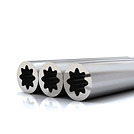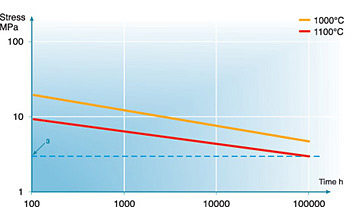Alleima® 353 MA* is an austenitic, chromium-nickel stainless steel contributing to longer tube life and reduced maintenance in a wide range of high-temperature applications.
Alloyed with nitrogen and rare earth metals (REM), Alleima® 353 MA is characterized by high performance in oxidizing, carburizing and nitriding environments.
| Grade | C | Si | Mn | P max. |
S max. |
Cr | Ni | N | Ce1) |
|---|---|---|---|---|---|---|---|---|---|
| Alleima® 353 MA (UNS S35315) |
0.07
|
1.6
|
1.5
|
0.040
|
0.015
|
25
|
35
|
0.16
|
0.05
|
1) To cerium should be added the quantity of other rare earth metals because the addition takes the form of misch metal containing about 50% Ce.
Finned tubes for ethylene furnaces
 The high resistance against carburization makes Alleima® 353 MA especially suited for finned tubes in ethylene furnaces. Combined with good oxidation properties at high temperatures, the use of Alleima® 353 MA finned tubes can contribute to longer production runs before decoking.
The high resistance against carburization makes Alleima® 353 MA especially suited for finned tubes in ethylene furnaces. Combined with good oxidation properties at high temperatures, the use of Alleima® 353 MA finned tubes can contribute to longer production runs before decoking.
Read more about the oxidation and carburization properties of Alleima® 353 MA
High creep strength
Alleima® 353 MA exhibits very good creep properties at high temperature and its creep strength meets the design requirements of steam cracking furnace tubes. The material's high content of nitrogen contributes to the high temperature strength.
Comparing Alleima® 353 MA with cast alloys, it can be seen that the creep strength is not as high. The additional strength in cast material is, however, normally not utilized, since the limiting factor for tube life is carburization and time between decoking.

Fabrication
The weldability of Alleima® 353 MA is good. Suitable welding methods are manual metal-arc (MMA) welding with covered electrodes and gas shielded arc welding with the TIG and MIG methods as first choice. Preheating and post-weld heat treatments are normally not necessary.
Compared with cast alloys, tubes in wrought alloys such as Alleima® 353 MA, can be produced in longer lengths. The longer length has cost advantages since less welding is required during fabrication of furnace coils. Wrought materials are also more ductile at room temperature. Consequently, welding is easier, especially after service exposure. Both cold bending and hot bending are possible depending on tube dimensions and the bending radius.
*353 MA is a trademark owned by Outokumpu OY.